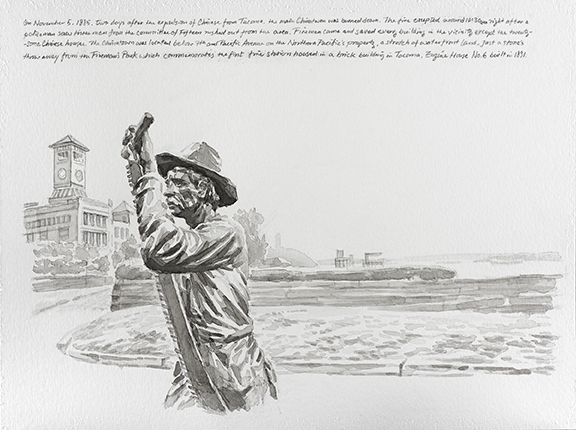Visitors to Tacoma often experience the painstakingly maintained and restored historic buildings of the city’s downtown as a glimpse into a prosperous, industrial past. The other side of the story is about those upon whose backs that prosperity was built, and that is the side depicted in Tacoma Art Museum’s latest exhibition, Zhi LIN: In Search of the Lost History of Chinese Migrants and the Transcontinental Railroads.
The exhibition by internationally acclaimed artist Zhi Lin includes works inspired by the indignities and persecution suffered by immigrant laborers that came part and parcel with the western expansion of the railroads in the 19th Century, but it has a strong focus on the dark events that unfolded in Tacoma on Nov. 3, 1885.
On that rainy day, a group of white Tacomans – with the support of much of the city – confiscated the businesses and property of Tacoma’s Chinese immigrants, drove them out of the city and burned their homes to the ground.
Zhi Lin’s research-based approach culminates in the center point of the exhibition: A 24-foot scroll (On November 3rd along Pacific Avenue in Tacoma, 2017) depicting a cityscape of modern downtown Tacoma, with period-accurate sketches of the Chinese immigrants being marched down Pacific Avenue toward the railway station with their tormentors lining the streets and office-building rooftops. The faces and hands are missing from the immigrants, effectively stripping them of identity.
Chief Curator Rock Hushka said the events of Nov. 3, 1885 weren’t spur-of-the-moment, and Zhi Lin’s art depicts that. “What happened that day was the result of many months of effort by the citizens of Tacoma, and Zhi Lin is very deliberate about calling it what it was: Ethnic cleansing. It was an orchestrated campaign, and for us to understand our shared history, he understands it’s important that we call it what it was.”
Further adding a sense of place to the persecution, the exhibition includes new notated ink sketches of locations in and around Tacoma that have a historic importance for the Chinese experience. These include Fireman’s Park (“Firemen came and saved every building in the vicinity except the twenty-some Chinese houses,” Lin’s notes recount) and Chinese Reconciliation Park (“…the Fuzhou Ting in the Chinese Reconciliation Park often has the US Navy ships in its background.”).

In telling the larger picture of the Chinese labor used in developing the First Transcontinental Railroad, Lin uses not just figurative art of the harsh landscapes and mountains through which the laborers trenched, but also includes abstract pieces representing what those workers saw, experienced and felt: A starry night sky (Constellations over the Sierra Nevada, 2016) filled with the same constellations that we see today. A storm on a mountainside (Snowstorm on the Cascade Summit Switchback, 2016) with a glimpse into the snowy white-out conditions the workers fought through.

“My intent is for the audience to imagine themselves as the migrants on that day, to feel their way into the work,” Lin said. “I want them to see not only the mountains and the snow, but also the workers and their gestures, their efforts.”
In pulling back the curtain on a lesser-known portion of Tacoma’s history, Zhi LIN: In Search of the Lost History of Chinese Migrants and the Transcontinental Railroads gives visitors and residents an authentic, no-holds-barred look at the complexities that underlie the outward beauty of Tacoma’s downtown and waterfront.
